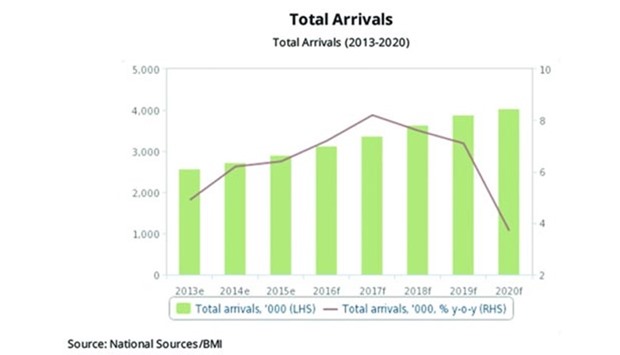National initiatives to enhance tourism flows into Qatar are showing positive results with inbound arrivals expected to reach 3.1mn this year, a 7.2% leap from 2015, a new report has shown.
Growth will remain strong until 2020, when inbound arrivals are expected to reach 4mn, BMI Research has said in a report.
Qatar’s inbound tourism total is expected to rise by 5.4% over 2016, the Fitch Group company said. As well as increasing the ability and demand for tourism into the country, there has also been work done to make it easier to enter and visitors from some 33 countries are now eligible for a tourist visa upon arrival.
The government has made moves to increase travel from the Asia Pacific market by decreasing bureaucracy, such as in Taiwan where travellers can now apply for visas online.
Work within the Gulf Co-operation Council (GCC) has also led to a Gulf-wide visa that allows for a Schengen style travel within participating countries, making travel within the region much easier and more convenient.
Europe and America will remain the dominant source markets for Qatar in general. Diversifying the country’s source markets is seen as essential for Qatari tourism’s sustainability.
The recent fall in oil price may affect the amount of inter-regional travel in the future, and as such the country must appeal to a wider range of markets (whilst still attracting regional travel).
Growth in the longer term will be aided by further international events providing an influx of tourists, but beyond this there are significant plans in place in order to strengthen all aspects of the industry.
The National Tourism Strategy 2030 has been implemented by the Qatar Tourism Authority to help drive a cohesive, national campaign to boost infrastructure, marketing, and accessibility, in order to increase absolute tourist numbers, BMI said.
Underlining the Qatari authorities’ commitment to boosting tourism flows over the long term, 2014 saw the launch of the Qatar National Tourism Strategy 2030.
As part of the strategy, Qatar wants to boost the number of international, non-regional tourists travelling to the country and promote sustainable tourism, as well as growing business and medical travel.
“Growth over the next five years is expected to be strong, as ties with regional neighbours increase and plans to become a tourist and travel hub continue to advance,” the report noted.
Tourism has been identified as one of the key areas of diversification for the Qatari economy, and the tourist industry is beginning to catch up with the more developed industries of its neighbours.
BMI also notes the priority given to promoting tourism by the local authorities and believes t`hat this, in tandem with Qatar’s hosting of the FIFA World Cup in 2022, is likely to see a rise in inbound tourism over our forecast period to 2020.
Qatar is currently a business destination, but BMI said there are “strides being made” to strengthen the cultural and leisure aspects of the industry.
The hosting of international sporting events will help put the country in the world’s eye as a tourist destination which will also lead to a diversification in the hotel market as companies look beyond the high-end hotel market in anticipation of a wider source market.
Additionally, it said the government has continued to improve air links into the country to encourage travel.
The Qatari government is also trying to boost entrepreneurship within tourism in order to encourage private sectors to innovate to meet demand in the market, BMI said.


